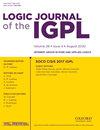Using Multi-Objective Optimization to build non-Random Forest
IF 0.8
4区 数学
Q2 LOGIC
引用次数: 0
Abstract
The use of multi-objective optimization to build classifier ensembles is becoming increasingly popular. This approach optimizes more than one criterion simultaneously and returns a set of solutions. Thus the final solution can be more tailored to the user’s needs. The work proposes the MOONF method using one or two criteria depending on the method’s version. Optimization returns solutions as feature subspaces that are then used to train decision tree models. In this way, the ensemble is created non-randomly, unlike the popular Random Subspace approach (such as the Random Forest classifier). Experiments carried out on many imbalanced datasets compare the proposed methods with state-of-the-art methods and show the advantage of the MOONF method in the multi-objective version.利用多目标优化构建非随机森林
使用多目标优化来构建分类器集合正变得越来越流行。这种方法可同时优化多个标准,并返回一组解决方案。因此,最终的解决方案可以更加符合用户的需求。这项工作提出了 MOONF 方法,根据该方法的版本,使用一个或两个标准。优化会将解决方案返回为特征子空间,然后用于训练决策树模型。与流行的随机子空间方法(如随机森林分类器)不同,该方法是以非随机方式创建集合的。在许多不平衡数据集上进行的实验将所提出的方法与最先进的方法进行了比较,并显示出 MOONF 方法在多目标版本中的优势。
本文章由计算机程序翻译,如有差异,请以英文原文为准。
求助全文
约1分钟内获得全文
求助全文
来源期刊
CiteScore
2.60
自引率
10.00%
发文量
76
审稿时长
6-12 weeks
期刊介绍:
Logic Journal of the IGPL publishes papers in all areas of pure and applied logic, including pure logical systems, proof theory, model theory, recursion theory, type theory, nonclassical logics, nonmonotonic logic, numerical and uncertainty reasoning, logic and AI, foundations of logic programming, logic and computation, logic and language, and logic engineering.
Logic Journal of the IGPL is published under licence from Professor Dov Gabbay as owner of the journal.

 求助内容:
求助内容: 应助结果提醒方式:
应助结果提醒方式:


